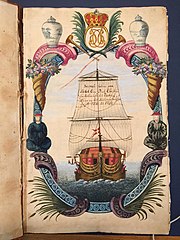Cron Printz Christian (DAC ship)
[1] During the attack on Marstrand, Varberg was one of three Swedish naval ships captured by Peter Tordenskiold and escorted to safety east of Koön.
Michael Christian Ludvig Ferdinand Tønder [da], a naval officer who had served under Tordenskiold in the Great Northern War, was selected as captain of the ship.
Peter van Hurk, a Dutchman who had completed four voyages to China with ships of the Dutch East India Company, was appointed as supercargo.
Christen Lintrup, who would later be raised to the peerage under the name Lindencrone, started his career in the Danish Asiatic Company as second assistant on the expedition.
The voyage was off to a bad start when foul weather took her too far north and a leak in the hull made it necessary to call at the Faroe Islands for repairs.
She then turned to a northeasterly course, directly towards the Sunda Strait, between Sumatra and Java, where in late June fresh supplies were taken aboard.
She was subsequently inspected both by Chinese customs officials and a Mandarin from the fort of Bocca Tigris before continuing up the river to anchorage of Whampoa.
Peter van Hurk and the other company traders rented a Chinese factory outside Canton proper as their headquarters.
They spent the next months purchasing more than a thousand crates of tea, 305 stacks of porcelain, 274 pieces of tuttenage metal (zinc oxide) as well as a range of other items.
In addition to this came 101 crates acquired as part of the salary of the captains, mates, company traders and other senior crew members.
saluted Kronborg on 11 January 1737 to mark the beginning of her voyage, picked the cargo up as planned, and arrived at Tranquebar on 27 July 1737.
Other written accounts of the voyage include Zimmer's tyrmandsoptegnelser fra rejse 1730-1732 and cadet Tobias Wigandt's diary from the expedition.
Third supercargo Joachim Bonasch and third mate Frederik Zimmer were all portrayed in Canton by one of the city's so-called face-makers.


